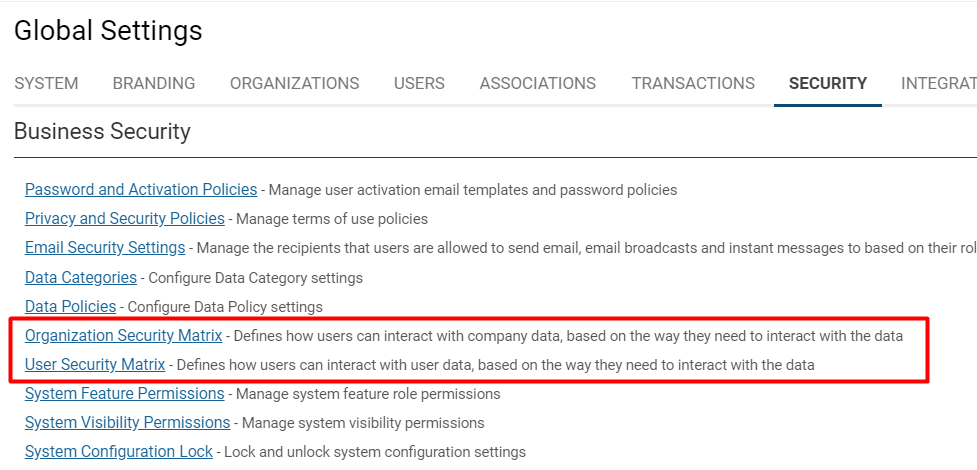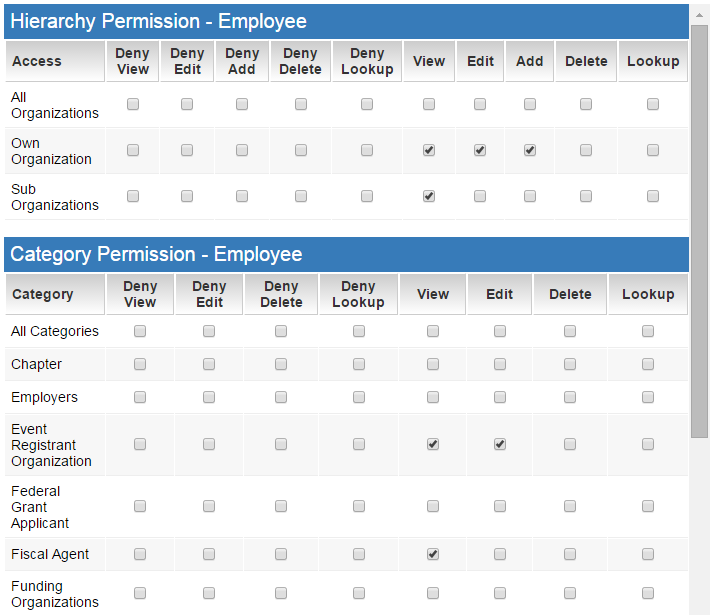Difference between revisions of "Company and User Security Matrix"
From SmartWiki
Greg Stanley (talk | contribs) (→Notes) |
|||
| (27 intermediate revisions by 4 users not shown) | |||
| Line 1: | Line 1: | ||
| − | |||
| − | |||
{| class="wikitable" | {| class="wikitable" | ||
|- | |- | ||
| − | |[[Image:How.png | + | ||[[Image:How.png|link=|50px]] |
| − | |This article will explain '''how''' you can implement this feature for use on your SmartSimple system. | + | ||This article will explain '''how''' you can implement this feature for use on your SmartSimple system. |
|} | |} | ||
==Overview== | ==Overview== | ||
==Enabling the Company and User Matrix== | ==Enabling the Company and User Matrix== | ||
| + | Note: You will need [[Global User Administrator]] Privileges to enable and configure this feature | ||
| + | |||
# In the '''Configuration''' menu, Click on '''Global Settings''' | # In the '''Configuration''' menu, Click on '''Global Settings''' | ||
# Under the '''Security''' Tab, add a check mark to the box '''Enable Company and User Security Matrix''' | # Under the '''Security''' Tab, add a check mark to the box '''Enable Company and User Security Matrix''' | ||
| − | # Click '''Save''' | + | # Click '''Save. ''' |
| + | |||
| + | :: [[File:Org and user security matrix.png|800px|border]] | ||
==Configuring the User Security Matrix== | ==Configuring the User Security Matrix== | ||
| − | + | * In the '''Configuration''' menu, click on '''Global Settings''' | |
| − | + | * Under the '''Security''' Tab, click on the '''User Security Matrix''' | |
| − | + | * Under the '''[[The Key Control Element – Roles|Login User Role]]''' select the user role you will be permissioning | |
| − | + | * First set '''Hierarchy Permissions''' if applicable - This sets what general permissions a specific user role has to view and modify based on the following options | |
| − | + | *:* '''Users Under All Organizations''' - access to all users under all organizations | |
| − | + | *:* '''Users Under their Own Organization''' - access to those users found under the current users organization | |
| + | *:* '''Users Under Sub Organizations''' - access to those users found under the current users organization or its sub-organizations | ||
| + | *:* '''Own Profile''' - access to users own profile | ||
| + | * Set '''Roles Permissions''' if applicable - This sets the granular role-by-role permissions to perform views, edits, deletes, and lookups. | ||
==Configuring the Company Security Matrix== | ==Configuring the Company Security Matrix== | ||
* In the '''Configuration''' menu, click on '''Global Settings''' | * In the '''Configuration''' menu, click on '''Global Settings''' | ||
| − | * Under the '''Security''' Tab, click on the '''Company Security Matrix'''This defines how users can interact with company data | + | * Under the '''Security''' Tab, click on the '''Company Security Matrix. '''This defines how users can interact with company data |
| − | * Under the '''Login User Role''' is displayed a list of all defined user roles. | + | * Under the '''Login User Role''' is displayed a list of all defined user roles. Select the user role you will be permissioning |
* Set appropriate '''Hierarchy Permissions''' if applicable - This sets what general permissions a specific user role has to view and modify organization data that they belong to. | * Set appropriate '''Hierarchy Permissions''' if applicable - This sets what general permissions a specific user role has to view and modify organization data that they belong to. | ||
| − | + | ** Options include the ability to view, edit, add, delete, and lookup permissions for '''All Organizations''', their '''Own Organizations''', and their '''Sub Organizations'''. | |
| − | + | ** By adding a check mark to the specific check box in the matrix you will be enabling that permission for the specified user role. | |
* Set '''Category Permissions''' if applicable - This sets granular category-by-category permissions to perform views, edits, deletes, and lookups. | * Set '''Category Permissions''' if applicable - This sets granular category-by-category permissions to perform views, edits, deletes, and lookups. | ||
| + | ==Permission Types== | ||
| + | The following 10 permission types are available: | ||
| − | + | * '''Deny View''' - Users in this role are denied access to this item. | |
| − | + | * '''Deny Edit''' - Users in this role can access but cannot edit. | |
| − | * '''Deny''' - Users in this role are denied access to this item. | + | * '''Deny Add''' - Users in this role can access but cannot create a new item. |
| + | * '''Deny Delete''' - Users in this role can access but cannot delete an existing item. | ||
| + | * '''Deny Lookup''' - Users in this role can access but cannot search an existing item. | ||
* '''View''' – View the item. | * '''View''' – View the item. | ||
* '''Add''' – Create a new item. | * '''Add''' – Create a new item. | ||
* '''Edit''' – Edit an existing item. | * '''Edit''' – Edit an existing item. | ||
* '''Delete''' – Delete an existing item. | * '''Delete''' – Delete an existing item. | ||
| − | |||
* '''Lookup''' – Search an existing item. | * '''Lookup''' – Search an existing item. | ||
| − | |||
==Company Security Matrix Example== | ==Company Security Matrix Example== | ||
| Line 48: | Line 55: | ||
[[Image:Company_security_matrix_2015-12-16_1531.png|link=]] | [[Image:Company_security_matrix_2015-12-16_1531.png|link=]] | ||
| − | |||
| − | |||
| − | |||
| + | A. From the '''Hierarchy Permissions''' - Employees can View, Edit, and Add data related to their Own Organization. | ||
| + | |||
| + | B. From the '''Category Permissions''' - Employees can View and Edit "Event Registrant Organization" and View "Fiscal Agents". | ||
| + | ==Notes== | ||
| + | * Only a {{GUA}} can define or modify [[Role|roles]]. | ||
| + | * When Company or User security matrix is enabled, then the system will ignore any other Company or User specific permissions when the current user is either a [[Local User Administrator]] or basic [[User]]. | ||
==Also See== | ==Also See== | ||
| − | [[Security Matrix]] | + | [[Security Matrix]]<br /> |
| − | + | [[The Key Control Element – Roles]]<br /> | |
| + | [[Using Roles]]<br /> | ||
| + | [[Roles & Permissions|Roles & Permissions]] | ||
| Line 65: | Line 77: | ||
{| class="wikitable" | {| class="wikitable" | ||
|- | |- | ||
| − | |[[Image:Why.jpeg | + | ||[[Image:Why.jpeg|link=?|50px]] |
| − | |Click [[Company and User Security Matrix - ?|here]] to learn why this feature is a benefit to your organization. | + | ||Click [[Company and User Security Matrix - Why?|here]] to learn why this feature is a benefit to your organization. |
| − | |} | + | |} |
| − | |||
| − | |||
| − | |||
| − | [[Category: | + | [[Category:How]][[Category:Security]] |
Latest revision as of 09:40, 13 February 2023

|
This article will explain how you can implement this feature for use on your SmartSimple system. |
Contents
Overview
Enabling the Company and User Matrix
Note: You will need Global User Administrator Privileges to enable and configure this feature
- In the Configuration menu, Click on Global Settings
- Under the Security Tab, add a check mark to the box Enable Company and User Security Matrix
- Click Save.
Configuring the User Security Matrix
- In the Configuration menu, click on Global Settings
- Under the Security Tab, click on the User Security Matrix
- Under the Login User Role select the user role you will be permissioning
- First set Hierarchy Permissions if applicable - This sets what general permissions a specific user role has to view and modify based on the following options
- Users Under All Organizations - access to all users under all organizations
- Users Under their Own Organization - access to those users found under the current users organization
- Users Under Sub Organizations - access to those users found under the current users organization or its sub-organizations
- Own Profile - access to users own profile
- Set Roles Permissions if applicable - This sets the granular role-by-role permissions to perform views, edits, deletes, and lookups.
Configuring the Company Security Matrix
- In the Configuration menu, click on Global Settings
- Under the Security Tab, click on the Company Security Matrix. This defines how users can interact with company data
- Under the Login User Role is displayed a list of all defined user roles. Select the user role you will be permissioning
- Set appropriate Hierarchy Permissions if applicable - This sets what general permissions a specific user role has to view and modify organization data that they belong to.
- Options include the ability to view, edit, add, delete, and lookup permissions for All Organizations, their Own Organizations, and their Sub Organizations.
- By adding a check mark to the specific check box in the matrix you will be enabling that permission for the specified user role.
- Set Category Permissions if applicable - This sets granular category-by-category permissions to perform views, edits, deletes, and lookups.
Permission Types
The following 10 permission types are available:
- Deny View - Users in this role are denied access to this item.
- Deny Edit - Users in this role can access but cannot edit.
- Deny Add - Users in this role can access but cannot create a new item.
- Deny Delete - Users in this role can access but cannot delete an existing item.
- Deny Lookup - Users in this role can access but cannot search an existing item.
- View – View the item.
- Add – Create a new item.
- Edit – Edit an existing item.
- Delete – Delete an existing item.
- Lookup – Search an existing item.
Company Security Matrix Example
1. Review the Hierarchy Permission and Category Permission shown below for the Employee Role:
A. From the Hierarchy Permissions - Employees can View, Edit, and Add data related to their Own Organization.
B. From the Category Permissions - Employees can View and Edit "Event Registrant Organization" and View "Fiscal Agents".
Notes
- Only a Global User Administrator can define or modify roles.
- When Company or User security matrix is enabled, then the system will ignore any other Company or User specific permissions when the current user is either a Local User Administrator or basic User.
Also See
Security Matrix
The Key Control Element – Roles
Using Roles
Roles & Permissions

|
Click here to learn why this feature is a benefit to your organization. |

